Outforia Quicktake: Key Takeaways
- Hummingbirds are known for having brightly colored, iridescent feathers and feeding on nectar.
- They are mainly pollinators, feeding on nectar from tubular flowers with their long beaks and tongues.
- The versatile hummingbirds are divided into two subfamilies, which include typical hummingbirds and hermit hummingbirds, further divided into different clades such as mountain gems and topazes.
- Most hummingbirds live in North, Central, and South America, but there are more than 300 different kinds of hummingbirds all over the world.
- Several hummingbird species are vulnerable, endangered, or critically endangered largely due to habitat loss and degradation, with many residing in unique habitats disrupted by human activities such as urban and agricultural development.
Hummingbirds are small, fast-flying birds mainly found in North America, Central America, and South America. Most types of hummingbirds found in the US live in the West.
Only one hummingbird species is found in the eastern US. However, most hummingbirds live in Central and South America in a variety of habitats.
There are over 300 different types of hummingbirds buzzing around the world.
What Are Hummingbirds?
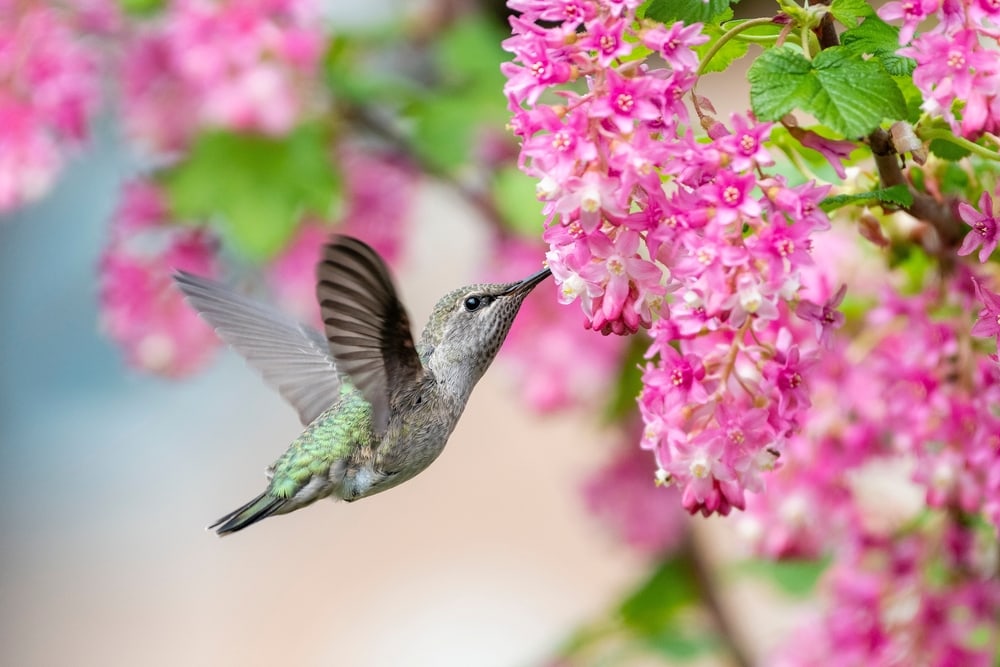
Hummingbirds are small birds best known for their brightly colored, iridescent feathers and nectar-feeding habits. Many hummingbirds are commonly seen in gardens and at hummingbird feeders.
While there are more than 300 types of hummingbirds, scientists are still discovering more.
Hummingbirds are separated into two subfamilies, which include typical hummingbirds and hermit hummingbirds. They’re further divided into different groups, or clades, such as mountain gems and topazes.
There are more than 100 genera of hummingbirds. Some hummingbird species have their genus in their names, such as firecrowns and sunangels.
Hummingbirds are pollinators that mainly feed on nectar from tubular flowers. They have long beaks and tongues that help them reach inside the deep corollas and drink nectar.
23 Types of Hummingbirds
As we’ve mentioned, there are more than 300 types of hummingbirds, mainly found in North America, Central America, and South America. We’ve compiled a list of 23 unique hummingbird species, ranging in size, preferred habitat, and range.
1. Giant Hummingbird
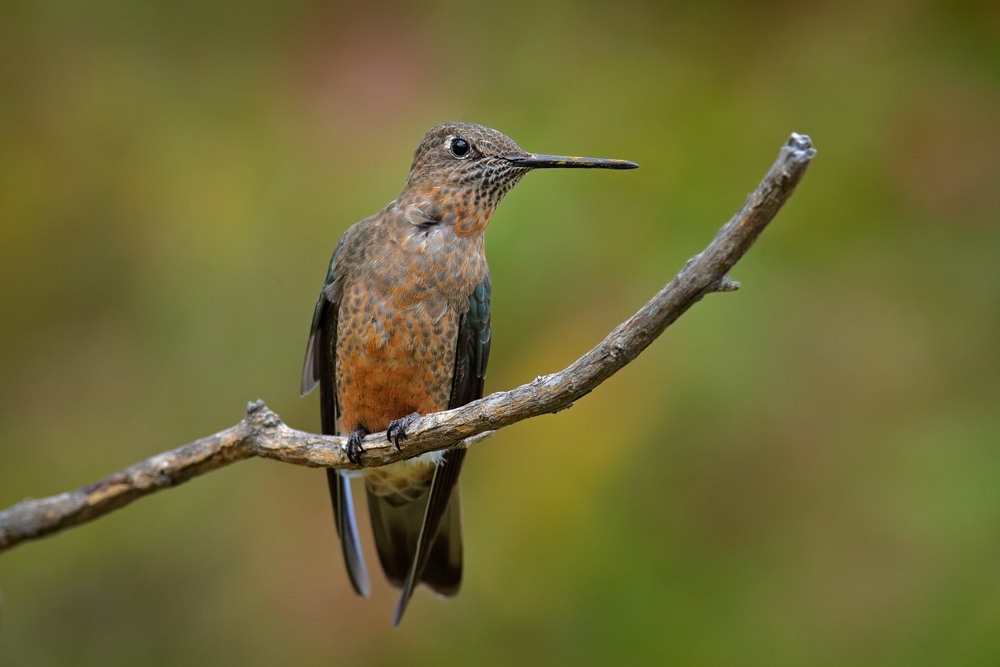
As the name suggests, the giant hummingbird is the largest hummingbird species. It measures up to 8 inches (20 cm) in length and has a slower wing beat compared to other species.
Giant hummingbirds live in the Andes mountain range in South America, from southern Colombia south to Argentina.
There are two subspecies that occupy different parts of their entire range, which include Patagona gigas gigas and Patagona gigas peruviana.
Giant hummingbirds live in arid habitats with little trees, ample flowers, and low-lying vegetation.
Some populations migrate to different areas after the breeding season. Breeding occurs at different times of the year, depending on their home range.
2. Bee Hummingbird
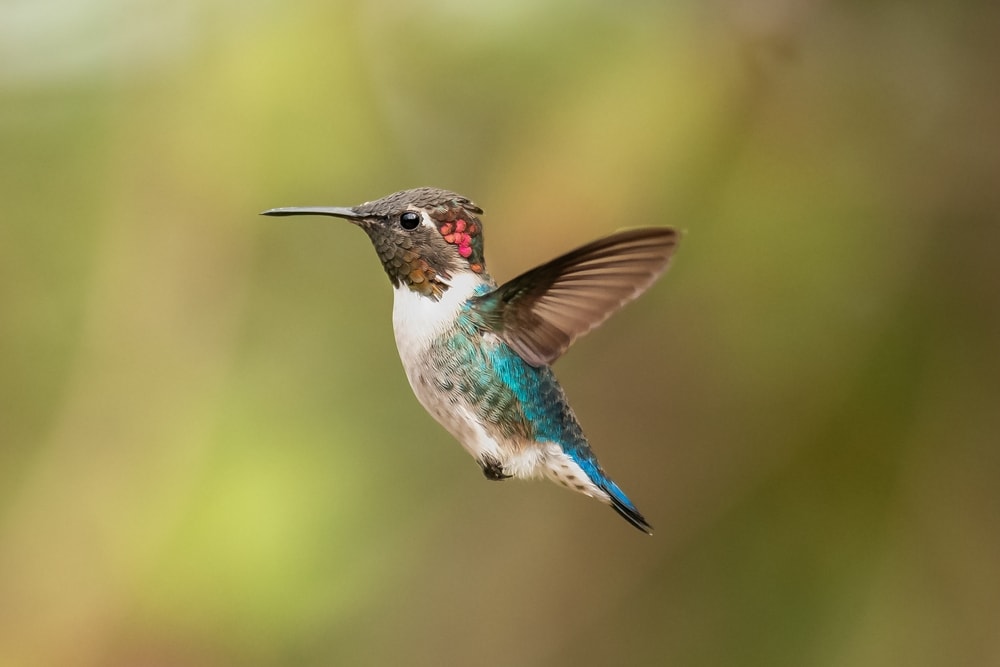
In contrast to the giant hummingbird, the bee hummingbird is the smallest hummingbird species. It’s also the smallest bird in the world!
Bee hummingbirds only reach about 2.25 inches (6 cm) in length and weigh less than 2 grams. Bee hummingbird eggs are about the size of a pea. These birds are so small that they’re often mistaken for large bees.
The bee hummingbird lives in the lowland forests of Cuba. It can also be found in swampy areas and gardens.
Many hummingbird species participate in short or long-distance migrations, but the subtropical climate of Cuba allows bee hummingbirds to remain in their home range year-round.
3. Ruby-throated Hummingbird
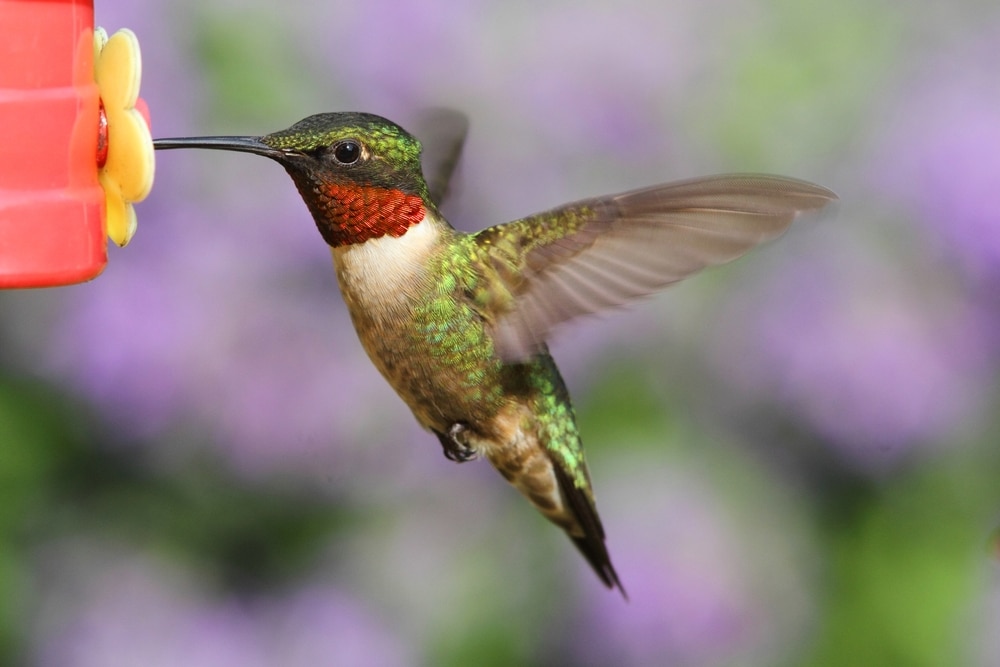
The ruby-throated hummingbird is a fairly common backyard visitor in the eastern half of the US.
While the western half of the US has several hummingbird species, the ruby-throated hummingbird is the only species found in the eastern US.
Male ruby-throated hummingbirds are easy to identify by their bright red throats. Females have a white throat. Like many birds, males have brighter plumage to impress females.
Ruby-throated hummingbirds participate in a long migration every year, beginning in late summer and early fall, to southern Mexico and Central America.
Once temperatures begin to rise again in the spring, ruby-throated hummingbirds return to their breeding range in the US and southern Canada.
Ruby-throated hummingbirds are commonly seen in semi-open habitats in southern Canada and the US during the spring and summer. Their overwintering grounds are mainly in dry tropical scrub habitats.
4. Glittering Starfrontlet
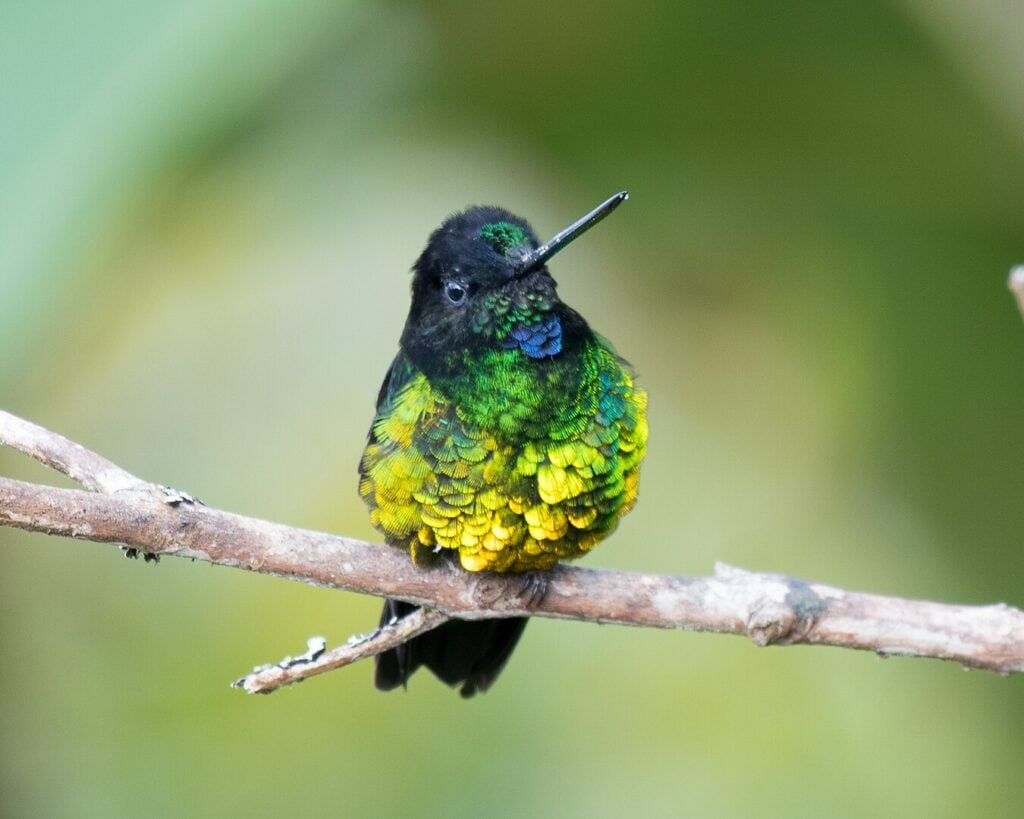
The glittering starfrontlet, also called the dusky starfrontlet, is an endangered hummingbird found in Colombia. It lives in a very unique habitat and climate in the high Andean montane forests and the páramo ecosystem.
Males are decorated with vibrant, iridescent green feathers on their chest and stomach. A patch of iridescent emerald feathers is located above the beak. A patch of iridescent royal blue feathers on the throat can also help identify them.
Females have less vibrant colors, with a white throat and green plumage on the head and body.
According to the International Union for Conservation of Nature (IUCN) Red List, the glittering starfrontlet has been previously classified as critically endangered since 2007.
In 2020, it was reclassified as endangered. It’s estimated that 250–2,500 individuals are left in the wild.
5. Blue-throated Hillstar
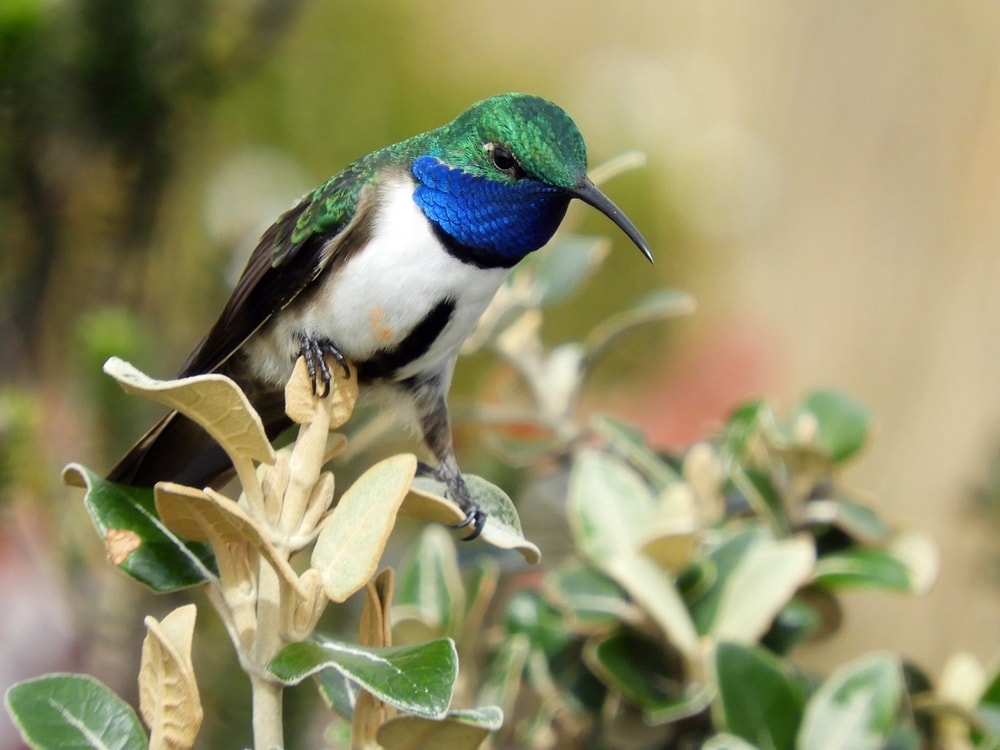
The blue-throated hillstar is named for the vibrant royal blue feathers on the throat of males. Females have a white throat with some speckled green feathers.
The blue-throated hillstar is a fairly new hummingbird species because it was first discovered in 2017 and scientifically described in 2018. It’s critically endangered and one of the most rare hummingbird species, with fewer than 110 individuals left.
These hummingbirds have only been found in southern Ecuador. They live in the high-altitude páramo ecosystem on the Cerro de Arcos rock formation.
Blue-throated hillstars have special adaptations that allow them to survive in their thin-air habitat. A protein called hemoglobin, present in blue-throated hummingbirds, helps deliver oxygen to the blood.
Many hummingbirds feed by hovering in place and rarely perching while feeding. To conserve energy in their low-oxygen environment, blue-throated hillstars perch to feed on nectar in flowers.
6. Chilean Woodstar
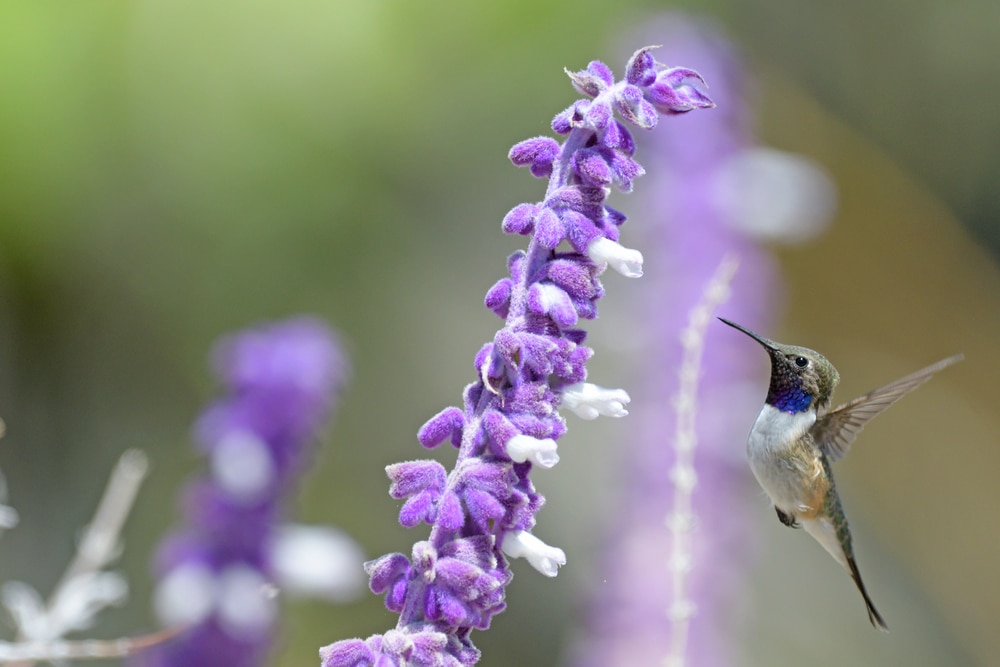
The Chilean woodstar is a small hummingbird species native to the river valleys in northern Chile. Other populations can also be found farther south in the Atacama Desert, known as the driest desert in the world.
Its range has been reduced significantly due to competition with the more aggressive Peruvian sheartail hummingbird and habitat loss.
The Chilean woodstar is critically endangered, and it’s estimated that only 210 individuals are left.
Male Chilean woodstars have a bright, iridescent magenta throat. Females have a white throat. The chest and stomach are white, and the back and head have dull green feathers.
7. Juan Fernández Firecrown
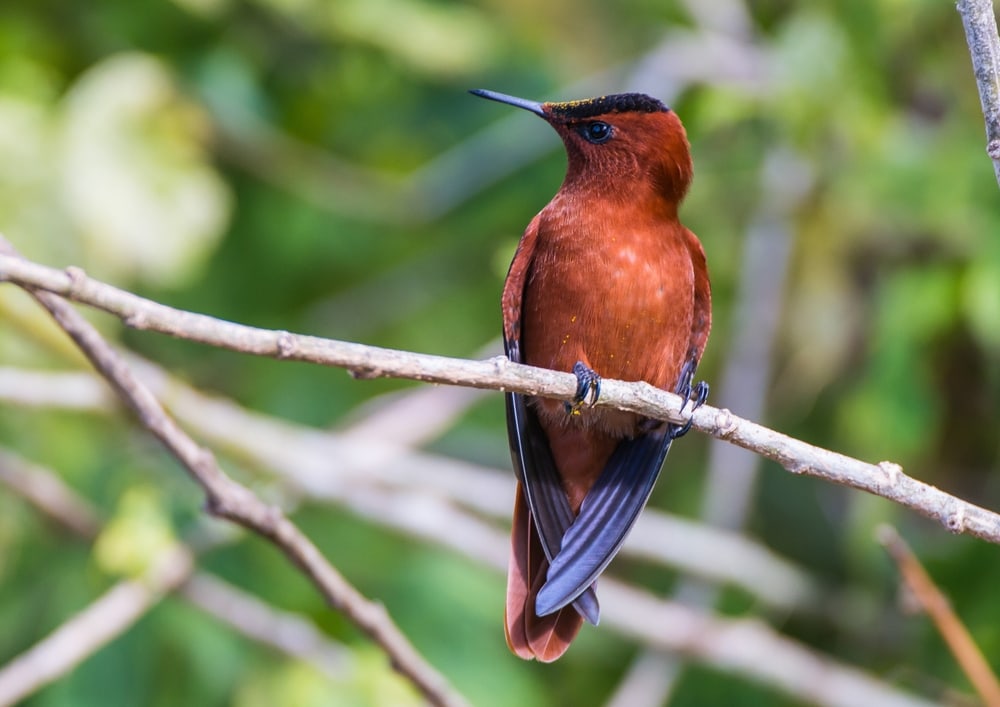
The Juan Fernández firecrown can only be found on Robinson Crusoe Island of the Juan Fernández archipelago off the coast of Chile.
Males are covered in fiery red plumage all over, with a black or green crown. Females have a completely different appearance. Females have a white belly speckled with green feathers and green and gold feathers on the head.
Juan Fernández firecrowns are critically endangered and face several threats. Invasive plants in their habitat overwhelm native food sources.
The introduction of the blackberry shrub has been especially harmful by overwhelming native vegetation. These hummingbirds are also threatened by habitat degradation. It’s estimated that there are 1,500–3,500 individuals left.
8. Black-chinned Hummingbird
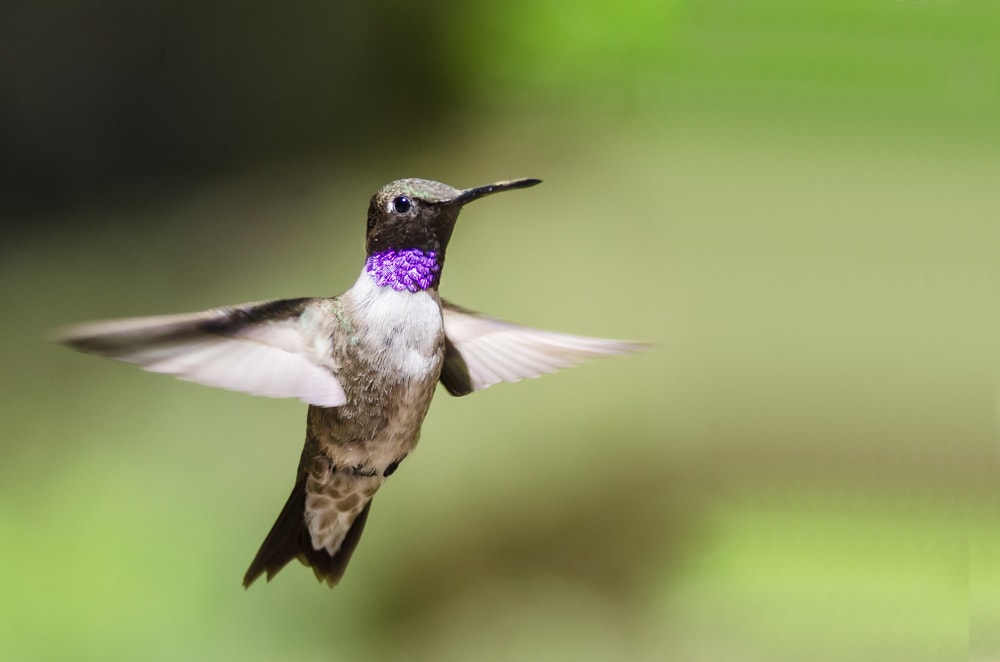
The black-chinned hummingbird is a fairly common species in the western US. It has adapted to a variety of habitats, including urban areas, along desert rivers with vegetation, and mountain forests.
Black-chinned hummingbirds may visit your backyard in the West if you have an abundance of native flowers.
Its breeding range stretches from southern British Columbia, Canada, south to Mexico. After the breeding season, populations winter along the Pacific Coast of Mexico.
Some hummingbird species are attracted to the color red, but black-chinned hummingbirds favor different colors based on the food source they recently visited.
9. Anna’s Hummingbird
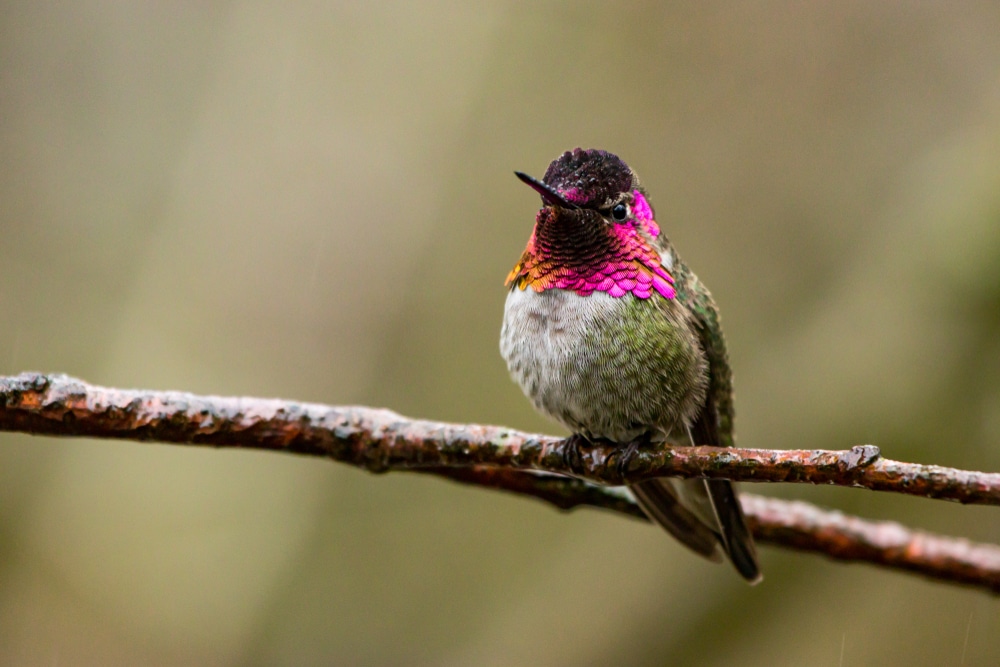
The Anna’s hummingbird is a year-round resident along the Pacific Coast of the US. Its permanent range extends from southern British Columbia south to Baja California, Mexico.
Anna’s hummingbirds are very common throughout their range, which is expanding farther north and eastward. It’s often seen in gardens, suburban areas with abundant flowers, and city parks.
Some populations living in the US may overwinter in Baja California, but others remain year-round.
Other populations participate in an east-west migration pattern from the Pacific Coast east to Arizona.
Males can be identified by a bright pink throat. Some males also have golden feathers mixed in with the pink. Immature males and females have white throats and green feathers on the head and back.
10. Rufous Hummingbird
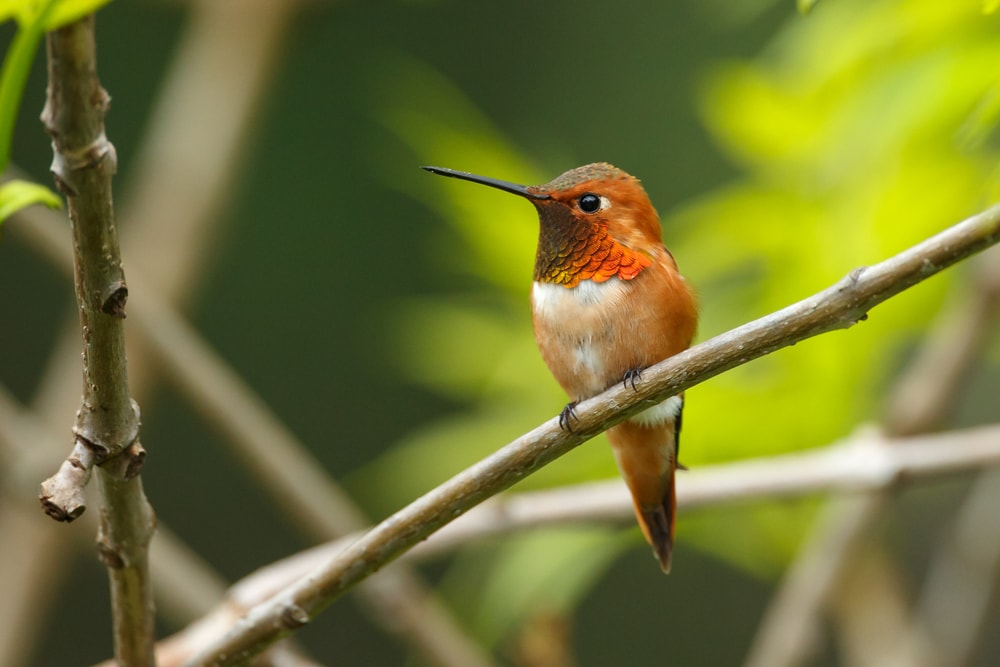
The rufous hummingbird is named for its rufous, or reddish-brown, color. Females and males both have a white chest.
Males have rufous-colored plumage on the head, neck, back, and sides. Females have some muted rufous feathers that stand out on their white stomachs.
Rufous hummingbirds are widely distributed throughout their range west of the Rocky Mountains. They’re highly migratory and spend most of their time on the move between breeding and non-breeding grounds.
They’ve been observed in California during the spring and as far north as the Pacific Northwest and Alaska during the summer. Some visit the Rocky Mountains region in the fall.
Their breeding grounds are concentrated in the Pacific Northwest, the Pacific Coast of British Columbia, and southeastern Alaska.
Individuals coming from Alaska may travel over 3,000 miles south to Mexico for the winter. Hummingbirds often make pit stops during migrations, so you may see them feeding on flowers during the late summer and fall.
11. Costa’s Hummingbird
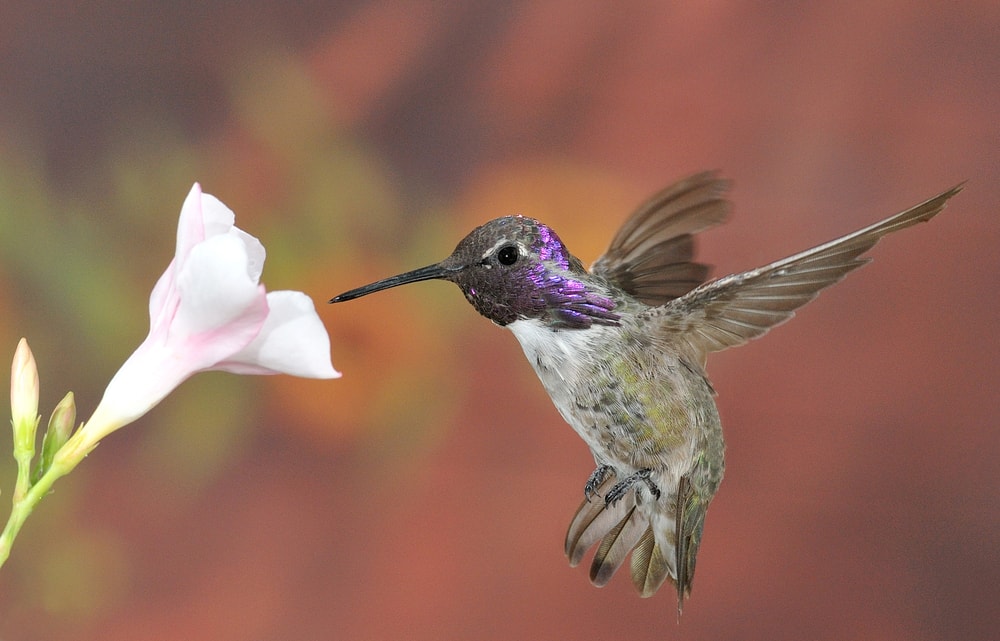
Found in the arid climates of the Sonoran and Mojave deserts of extreme southern California and Arizona, the Costa’s hummingbird This species is a year-round resident of these regions and Baja California.
The Costa’s hummingbird participates in short migrations to the Pacific Coast of California and Baja California during the summer to avoid higher temperatures associated with inland regions.
In preparation for winter, some individuals may travel farther south in northern Mexico.
Costa’s hummingbirds are important to their desert habitats because they pollinate a variety of desert plants and cacti.
12. Allen’s Hummingbird
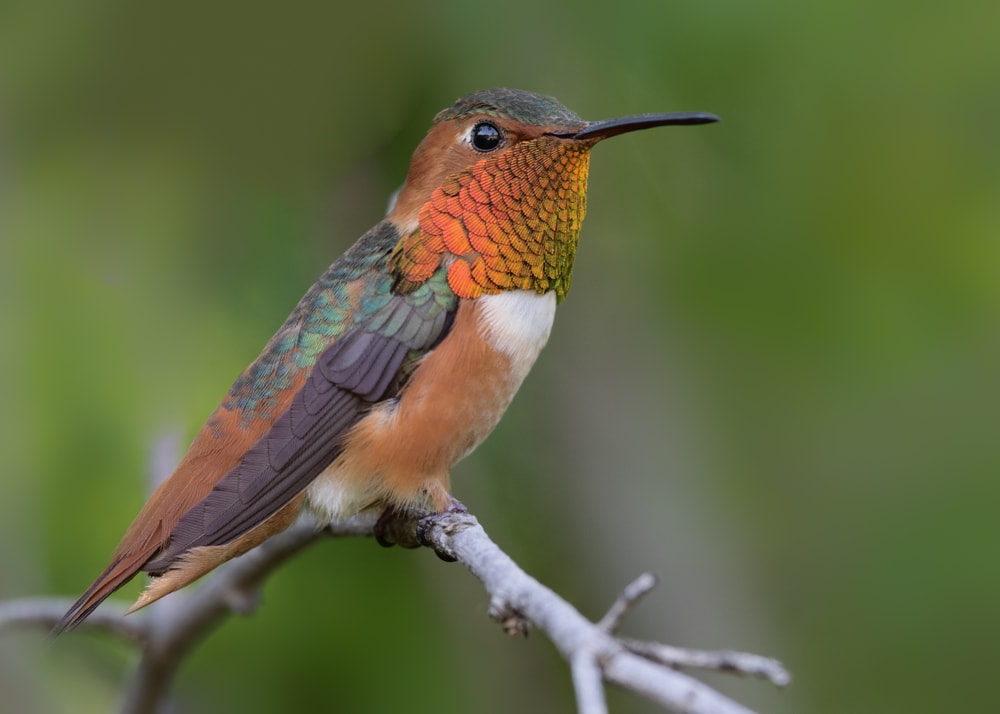
Allen’s hummingbirds are native to the extreme western US along the Pacific Coast, from Oregon south to central Mexico.
Their breeding grounds are in Oregon and California. They usually arrive in early spring for the breeding season. Their non-breeding range is in central Mexico.
There are two subspecies of Allen’s hummingbirds, which include Selasphorus sasin sasin and Selasphorus sasin sedentarius. The S. s. sedentarius The subspecies is usually a year-round resident of southern California, while the other species overwinters in Mexico.
Allen’s hummingbirds have adapted to urban areas with abundant food sources. This species prefers red tubular flowers, such as the red monkey flower and red columbine.
13. Marvelous Spatuletail
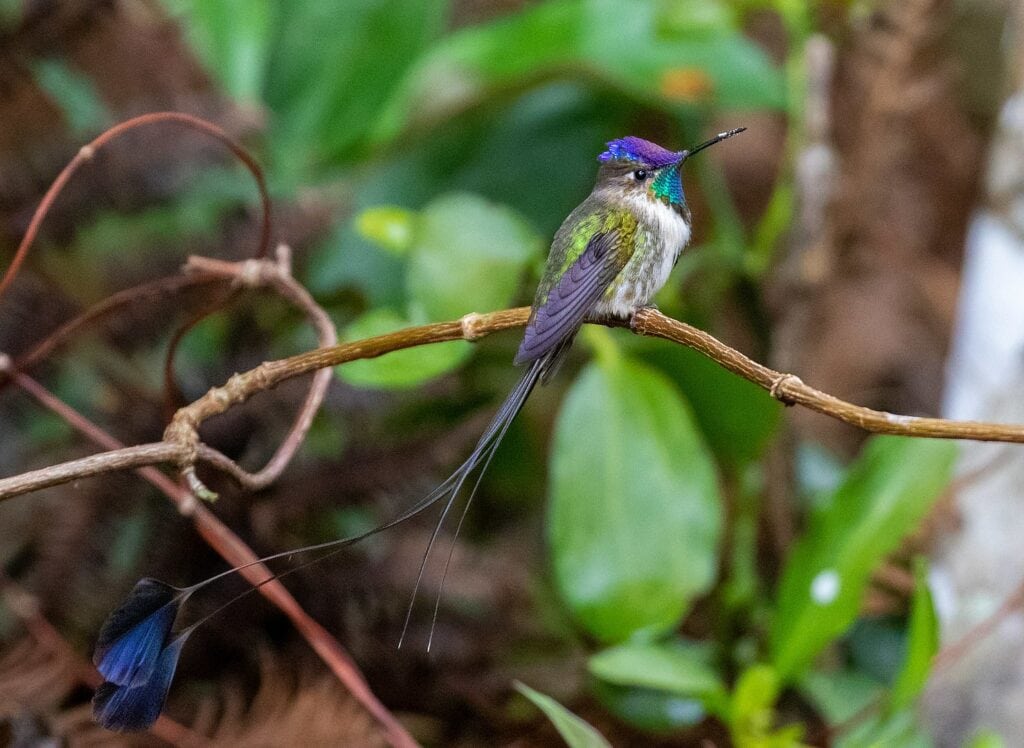
The marvelous spatuletail is an endangered hummingbird found in only one region of northern Peru. Their range is restricted to the slopes of the Utcubamba River Valley at elevations between 6,890 and 9,514 ft (2,100 and 2,900 m).
Marvelous spatuletails are endangered, mainly due to habitat loss. Deforestation and wood burning for agriculture are the primary reasons for habitat loss.
The marvelous spatuletail was last assessed by the IUCN in 2016, and it’s estimated that 250–999 individuals are left.
14. Calliope Hummingbird
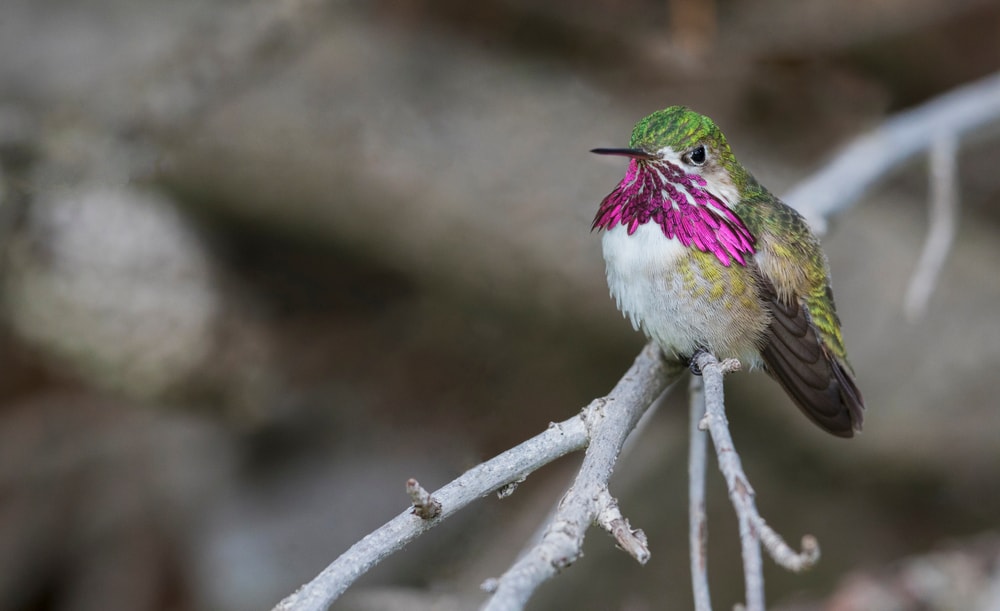
The calliope hummingbird is found in the northwestern US during the spring and summer breeding seasons. By fall, calliope hummingbirds migrate south to Mexico.
The northernmost populations occur in southern Canada. Their migration route follows an oval pattern. Their migration south often takes place more inland, while their trip back up to the US from Mexico occurs along the Pacific Coast.
Calliope hummingbirds are one of the smallest hummingbird species. It’s the smallest bird found in North America, measuring about 3 inches (7.6 cm) in length.
Calliope hummingbirds are fairly common throughout their range. It’s estimated that 4.5 million mature individuals exist in the wild.
15. Rivoli’s Hummingbird
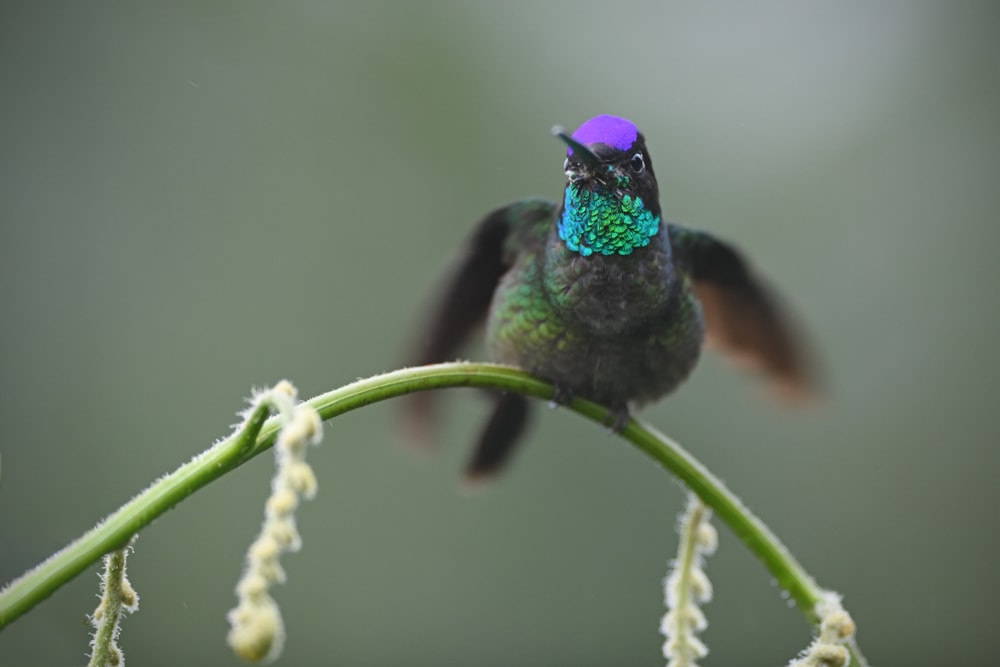
Rivoli’s hummingbirds are permanent residents of Mexico but can also be found in the southwestern US. Their range extends as far south as Nicaragua in Central America.
The Rivoli’s hummingbird was originally named the magnificent hummingbird.
In 2017, ornithologists decided to separate the species into two groups according to different populations and their ranges. As a result, the talamanca hummingbird was described as the other species that occurs in Costa Rica and Panama.
The Talamanca hummingbird has a different appearance than the Rivoli’s hummingbird. Male Talamanca hummingbirds have a blue throat, while Rivoli’s hummingbirds have a purple throat.
16. Blue-throated Mountain Gem
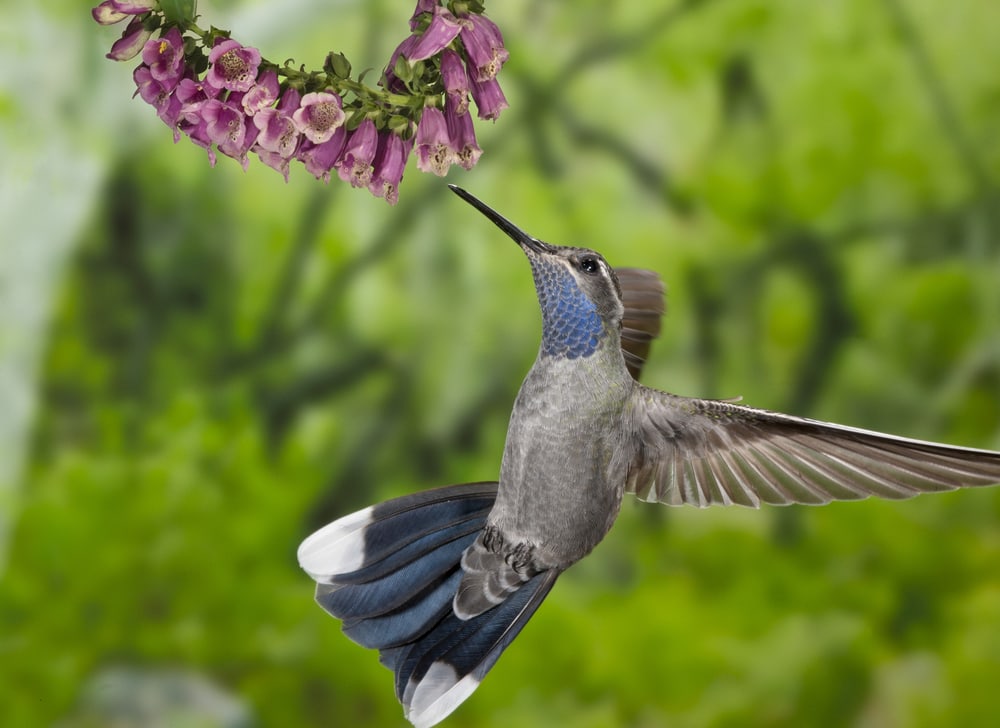
As the name suggests, the blue-throated mountain gem is named for its blue throat and mountain habitat. This species is one of the largest hummingbirds found in the US.
Blue-throated mountain gems can be found in Arizona, New Mexico, and Texas during the breeding season. In Mexico, they’re year-round residents.
Females have green feathers on the back and head, with a grayish-white throat and chest.
Males have a blue throat, gray chest and stomach, and brownish-gray and green feathers on the back and head. White stripes are located behind the eyes of males and females.
17. Lucifer Hummingbird
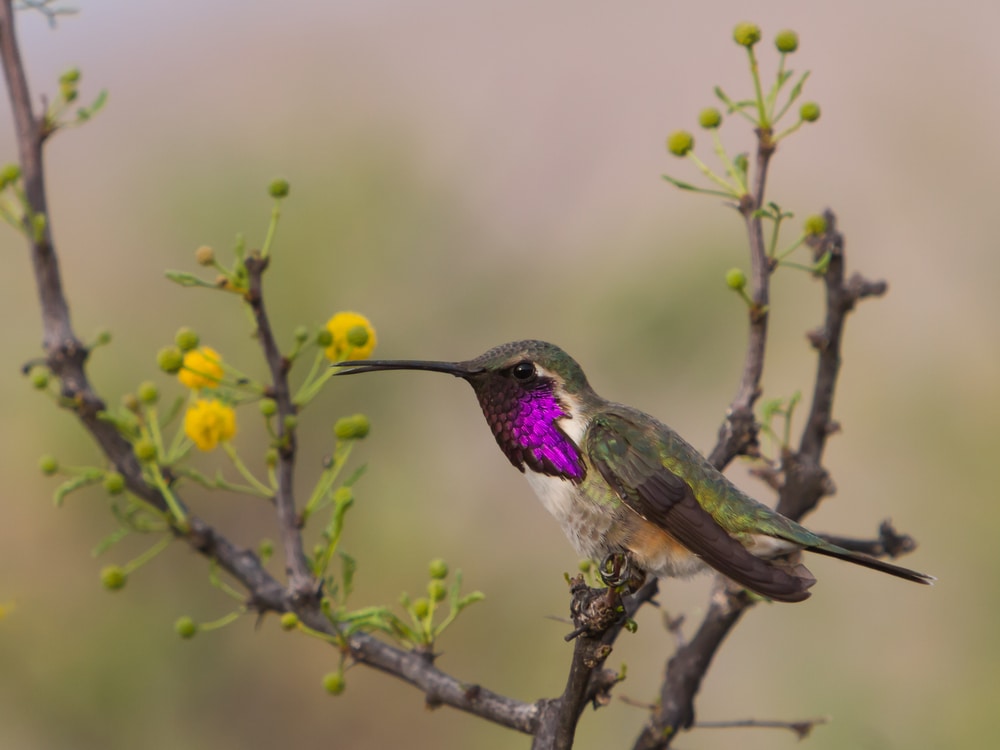
The Lucifer hummingbird lives in arid desert regions in the extreme southwestern US, south to Mexico. Populations in central Mexico typically don’t migrate. Other populations migrate north to breeding grounds in Arizona, New Mexico, and Texas.
Males have an iridescent purple throat with some magenta coloring. Underneath these feathers, some white peaks out on the chest. The rest of their body is covered in gray and green feathers.
Lucifer hummingbirds have a long, slightly curved beak, perfect for reaching nectar on agave stalks.
18. Broad-tailed Hummingbird

The broad-tailed hummingbird is common in the western US during the summer breeding season. Its range stretches as far north as southern Montana. It’s found as far west as the border of California and Nevada and east of Colorado.
In the US, the southernmost portion of their range stretches down to Arizona and New Mexico.
Their preferred habitat includes open and semi-open woodlands and meadows in mountainous regions. Populations migrate south to Mexico for the winter.
To impress females, male broad-tailed hummingbirds put on a flight show by flying high in the air and swooping down rapidly and back up again.
19. Buff-bellied Hummingbird
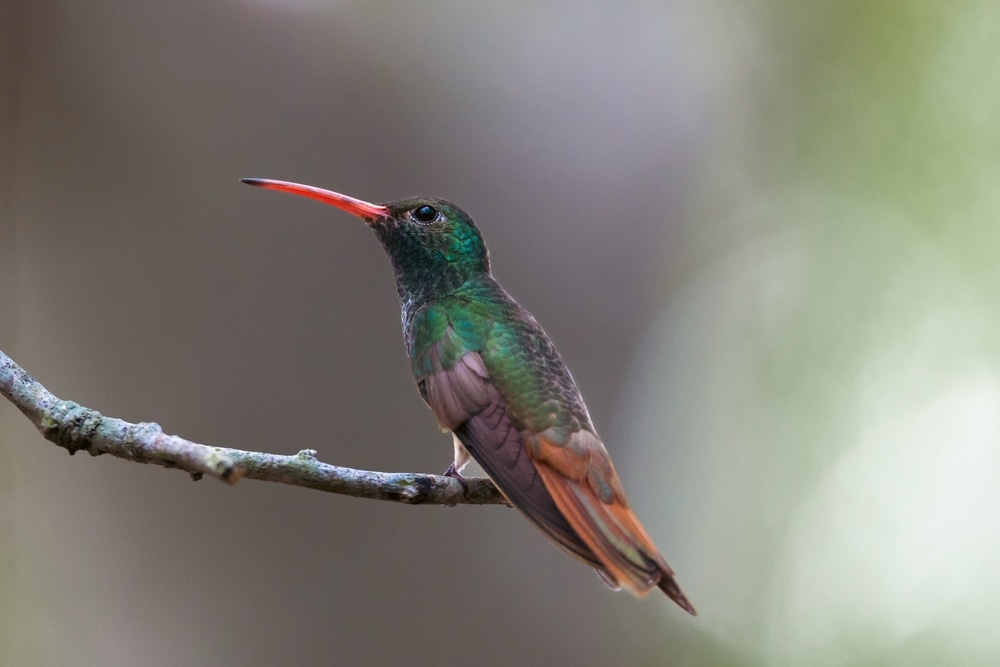
The buff-bellied hummingbird is a year-round resident along the Gulf Coast of Mexico, from the Yucatán Peninsula north to extreme South Texas. During the breeding season, it can be found as far east as northwestern Florida.
Many hummingbirds have black beaks, but buff-bellied hummingbirds have a red beak. It also differs from other species because it moves north after the breeding season instead of south.
Buff-bellied hummingbirds prefer semi-open habitats, such as open woodlands. They also occur in suburban areas with an abundance of floral resources from gardens.
20. Amethyst-throated Sunangel
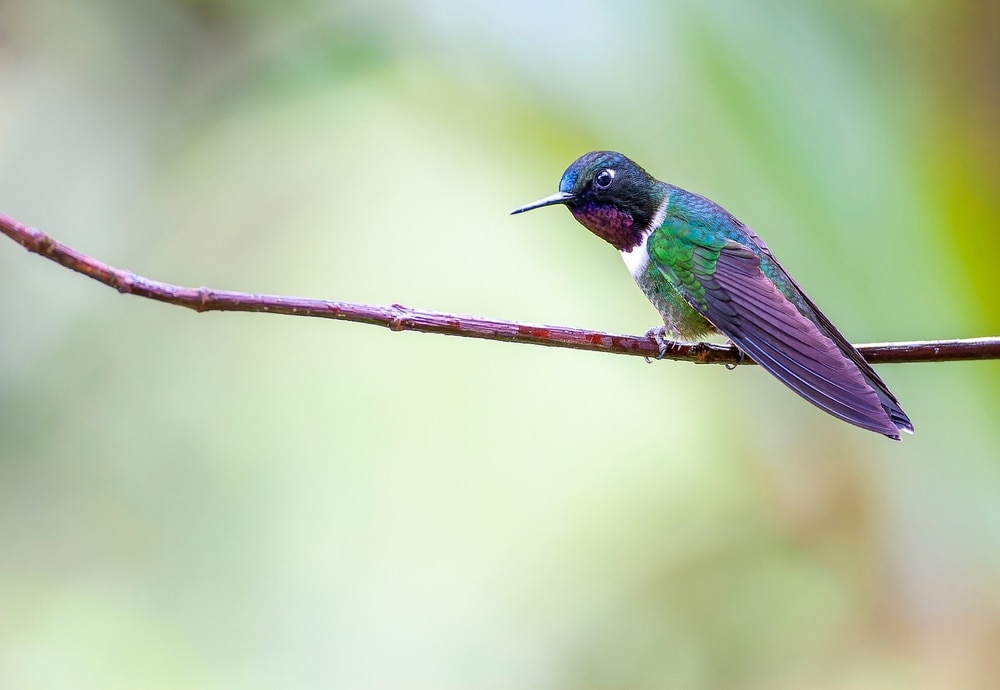
The amethyst-throated sunangel is a common hummingbird native to South America. It inhabits humid montane evergreen forests in the Andes of Ecuador, Peru, and Bolivia year-round.
There are four subspecies of amethyst-throated sun angels recognized. The subspecies can be distinguished by the colors of their throat and crown.
While many female hummingbirds lack the brightly colored throats males have, some female subspecies of this hummingbird have bright purple throats.
The beak of amethyst-throated sunangels isn’t as long as that of some hummingbird species. Due to their shorter beaks, they prefer to feed on flowers with shorter corollas.
21. Ruby-topaz Hummingbird
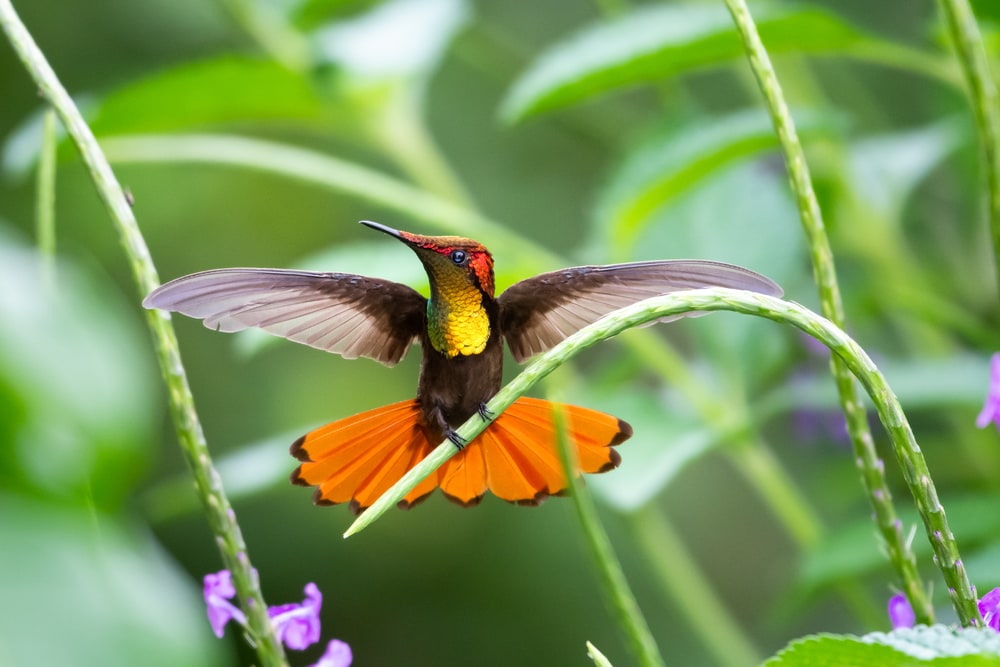
Male ruby-topaz hummingbirds are hard to miss with their vibrantly colored red and golden crown and throat. They also sport reddish-orange on the underside of their tail feathers. Some males have bright green plumage mixed in with their red and golden throats.
Females are less vibrant but have some orange feathers mixed in with brown and green feathers on the back and head.
The total population number of ruby-topaz hummingbirds is unknown, but they’re fairly common throughout their range. They can be found in various lowland and open habitats, including agricultural areas and urban habitats.
They mainly occur in northern South America, including central Brazil and south to Bolivia. Some populations participate in short migrations throughout their range, but many stay put year-round.
22. Fiery-throated Hummingbird
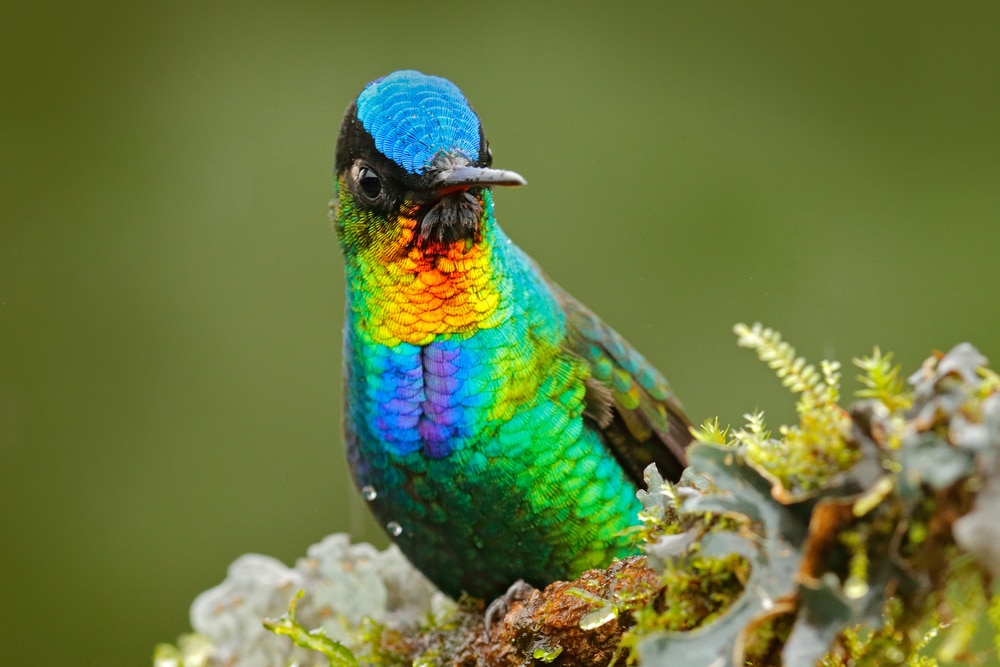
The fiery-throated hummingbird is a very colorful species, with iridescent green, turquoise, and blue feathers decorated all over the body. Their name comes from the orange and yellow feathers on their throat.
Fiery-throated hummingbirds are native to southern Central America. They’re mainly found in the highlands of Costa Rica and the Chiriquí mountains of Panama.
Two subspecies are recognized, which include Panterpe insignis insignis and P. i. eisenmann.
Unlike many hummingbirds in the US that breed during the summer, this species breeds between late summer and early winter. In the spring, some populations leave their high montane evergreen and cloud forest habitats and migrate to lower elevations.
23. Swallow-tailed Hummingbird

The swallow-tailed hummingbird is named for its deeply forked tail feathers. Males have a bright royal blue throat and head.
The largest portion of the range is in eastern and southeastern Brazil. They also live in southeastern Peru, Bolivia, and eastern Paraguay.
Parts of their range are protected reserves, including the Mata do Passarinho Reserve and the Serra do Urubu Reserve.
These reserves support swallow-tailed hummingbirds by providing gardens with abundant floral resources.
It’s a fairly common and widely distributed species. Some visit urban areas, such as parks with food sources.
Interesting Facts About Hummingbirds
1. Hummingbirds beat their wings really fast.
Hummingbirds are known for their super-fast wing beats. Larger hummingbirds have slower wing beats compared to smaller species.
Most hummingbirds beat their wings around 50–60 times per second!
Large species, like the giant hummingbird, beat their wings less than 20 times per second. The bee hummingbird can beat its wings 80 times per second on average.
During courtship, males can beat their wings up to 200 times per second.
2. Most hummingbirds feed by hovering.
It’s uncommon for hummingbirds to stop and rest on branches or stems while feeding.
Hummingbirds have a greater range of motion when it comes to flying compared to other types of birds. They can fly forward, backward, and sideways.
When feeding, they hover over flowers and then zip right over to the next one. Not all hummingbirds hover while feeding. Some species prefer to perch. Hummingbirds will also perch to rest.
3. Some hummingbird species are very territorial.
Hummingbirds are typically very territorial or not aggressive over territory at all.
More aggressive hummingbirds will chase off other individuals and even other types of animals from feeding and nesting sites. This can create a problem for other, less territorial hummingbirds that live in the same range as territorial species.
4. Nectar is the primary food source of hummingbirds.
Most of a hummingbird’s diet is made up of nectar from flowers. Due to their diet, hummingbirds are important pollinators. As they stick their beaks into flowers, they collect pollen on their heads.
Some species prefer red flowers, while others don’t care too much about color. Hummingbirds with longer beaks feed on tubular flowers, while those with shorter beaks feed on flowers with shorter corollas.
While hummingbirds are described as nectivores, they also eat insects. Most hummingbirds feed on insects by scooping them up in midair.
You may also like: How Do Birds Mate & Where Do Eggs Come From?
Hummingbird Conservation
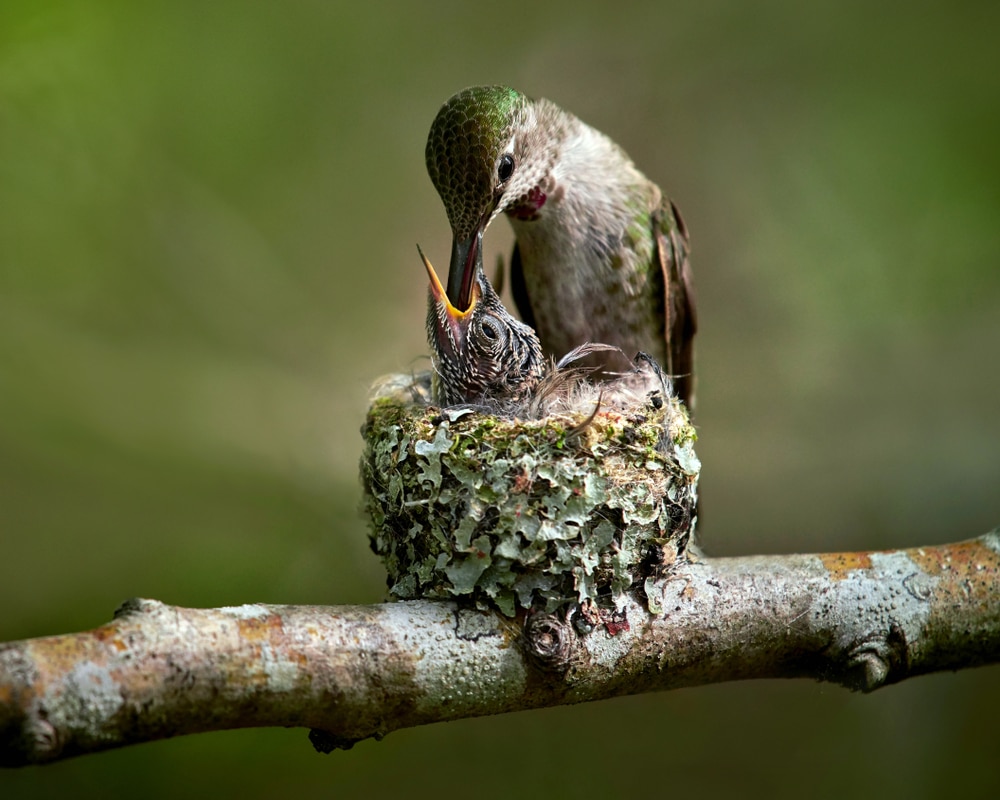
There are many hummingbird species that are vulnerable, endangered, or critically endangered. Habitat loss and degradation is one of the primary threats to many species.
Many types of hummingbirds live in very unique habitats that have become disturbed by human activities, such as urban and agricultural development.
Some hummingbirds are also threatened by invasive plants that overwhelm native floral resources.
There are several conservation organizations dedicated to researching and protecting hummingbird populations and habitat.
For example, the International Hummingbird Society coordinates with other conservation organizations to provide support for natural reserves that protect hummingbird habitats.
Hummingbirds play a vital role in pollinating native flowers. Many hummingbirds have special beaks for specific types of flowers.
Similarly to bees, if hummingbirds went extinct it would cause a great amount of harm to other animals, plants, and throw off entire ecosystems.
You may also like: Ten Desert Birds and Their Unique Adaptations
Hummingbirds FAQs
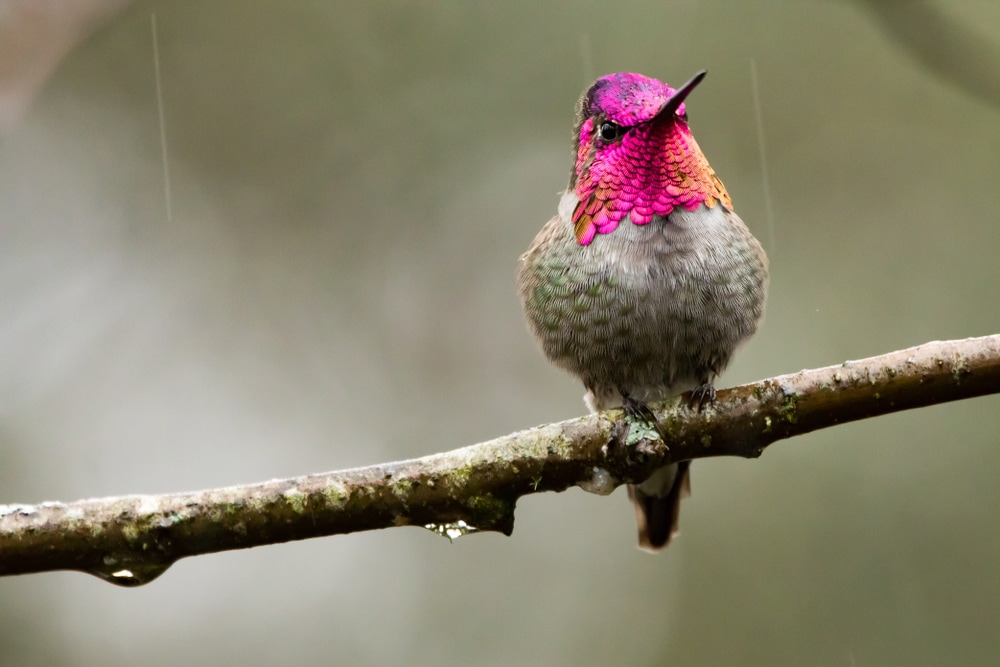
Where do hummingbirds go at night?
Hummingbirds typically rest in trees and other types of vegetation at night. Some individuals may perch and sleep, while others hang upside down to sleep like bats.
On cold nights or during the winter, hummingbirds may go into a dormant state called torpor to conserve energy
What eats hummingbirds?
Hummingbirds fall prey to larger birds, such as hawks and owls. Predators can depend on specific species and where they live.
Smaller hummingbirds can also get caught in spider webs and fall prey to large spiders in South America.
How fast can hummingbirds fly?
Along with their superfast wing beats, hummingbirds are capable of traveling more than 30 mph (48 kph). Speed can depend on species, but some can zip around at speeds up to 60 mph (96.5 kph).
The Anna’s hummingbird is recognized as the fastest-flying hummingbird species. It can travel at more than 60 mph.









